Lots of cameras are listed as being weatherproof, but some are a bit more resistant to weather than others. In this buyer’s guide to the best weatherproof cameras, we’ll list the cameras that we have exposed to heavy rain (or worse) and they’ve survived. In our view and our experience, they are the most weatherproof cameras. And yes, a few other cameras have died at our hands.
Weatherproof vs Waterproof
It’s important to remember that weatherproof and waterproof have different meanings. A waterproof camera can be taken below the surface of the water down to a specified depth. A weatherproof camera is not designed for that kind of treatment. It should withstand some rain, but if you submerge it, it’s likely to be the end of the story.
We’ve included some of the best waterproof cameras in this buyer’s guide because they are also weatherproof. And of course, the most waterproof cameras are also the most weatherproof cameras.
Does rain affect a weatherproof camera?
While all the cameras in this guide continued to operate and deliver the quality of images and video that we’d expect from them, water droplets can give touchscreens an issue. In some cases, you may need to use the physical controls rather than the screen. However, a quick wipe will often make teh screen perform as normal.
Raindrops can also be problematic for the eye sensor of an electronic viewfinder. A drop or two on it can trick the camera into thinking that the viewfinder is in action.
If you find that the screen of your weatherproof camera isn’t displaying the image preview or menu, take a look at the viewfinder’s eye sensor. If that has a drop or two of water on it, a wipe with a cloth will solve the problem.
In really heavy rain, you may need to turn the eye sensor off and switch manually between the finder and the main screen.
What should I do if my camera gets wet?
Even if your camera is weatherproof, you shouldn’t open any ports or remove the lens when it’s wet.
Also, if your camera gets wet, avoid putting it down on a hard surface that will allow any water to pool around its base. That would mean it would be sitting in a puddle of water and the battery compartment may not appreciate it.
Naturally, you should try to dry your camera as soon as you can. Use a soft cloth and give it a good (but gentle) rub down until there’s not a drop of water visible.
Then, if possible, leave your camera somewhere well ventilated and warm, but not hot, for an hour or so. The aim is to let any last bits of moisture lurking in any crevices and seams to evaporate.
Even if your camera is waterproof, wait until you are 100% certain that your camera is dry before you open the battery or memory card compartment, change the lens or use one of the connection ports.
DJI Osmo Action
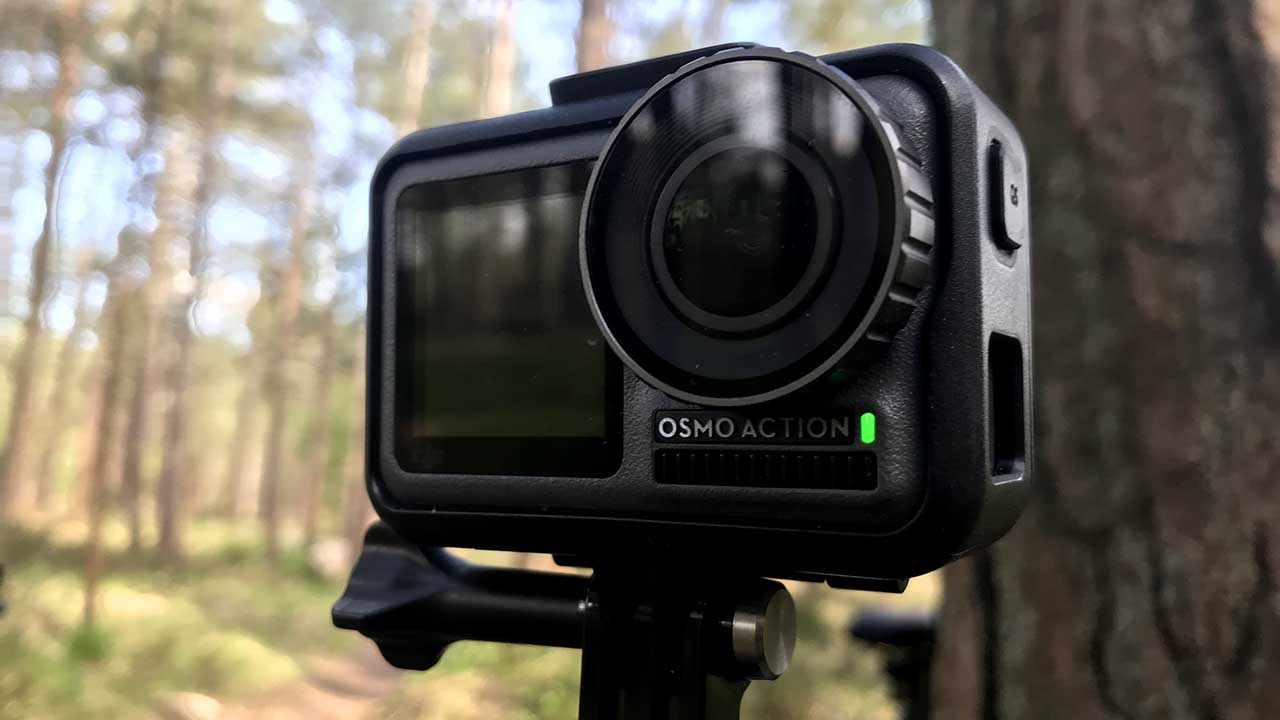
Specification
- Camera type: Action camera
- Sensor: 12Mp 1/2.3-inch CMOS
- Dimensions: 65 x 42 x 35mm
- Max video resolution: 4K (16:9) – 60, 50, 48, 30, 25, 24fps
- Weight: 124g
The Osmo Action is a great action camera and it’s designed to be used on land and in water. But we don’t take these things for granted. I’ve had a so-called waterproof action camera fail on me on more than one occasion in the past.
I had the DJI Osmo Action in for testing when I went to the French Alps in the summer of 2019 and a white water rafting trip was an excellent opportunity to test its weatherproofing. As well as being submerged just about every time I used my paddle, both it and I ended up bobbing along in the wild water on more than one occasion.
Happily, the Osmo Action survived the experience and delivered super-quality video.
My only disappointments were the rather muffled audio and the fact that in n 16:9 4K mode at 60fps with the RockSteady stabilisation active, I only got 24minutes of footage from a single battery. I had a spare battery, but the middle of a raging river is not the place to change it.
£229
$234.00For
- Excellent video quality
- Robust build
- Excellent Rock Steady stabilisation
Against
- Battery life could be better
- No live-streaming capability
Fujifilm X-Pro3
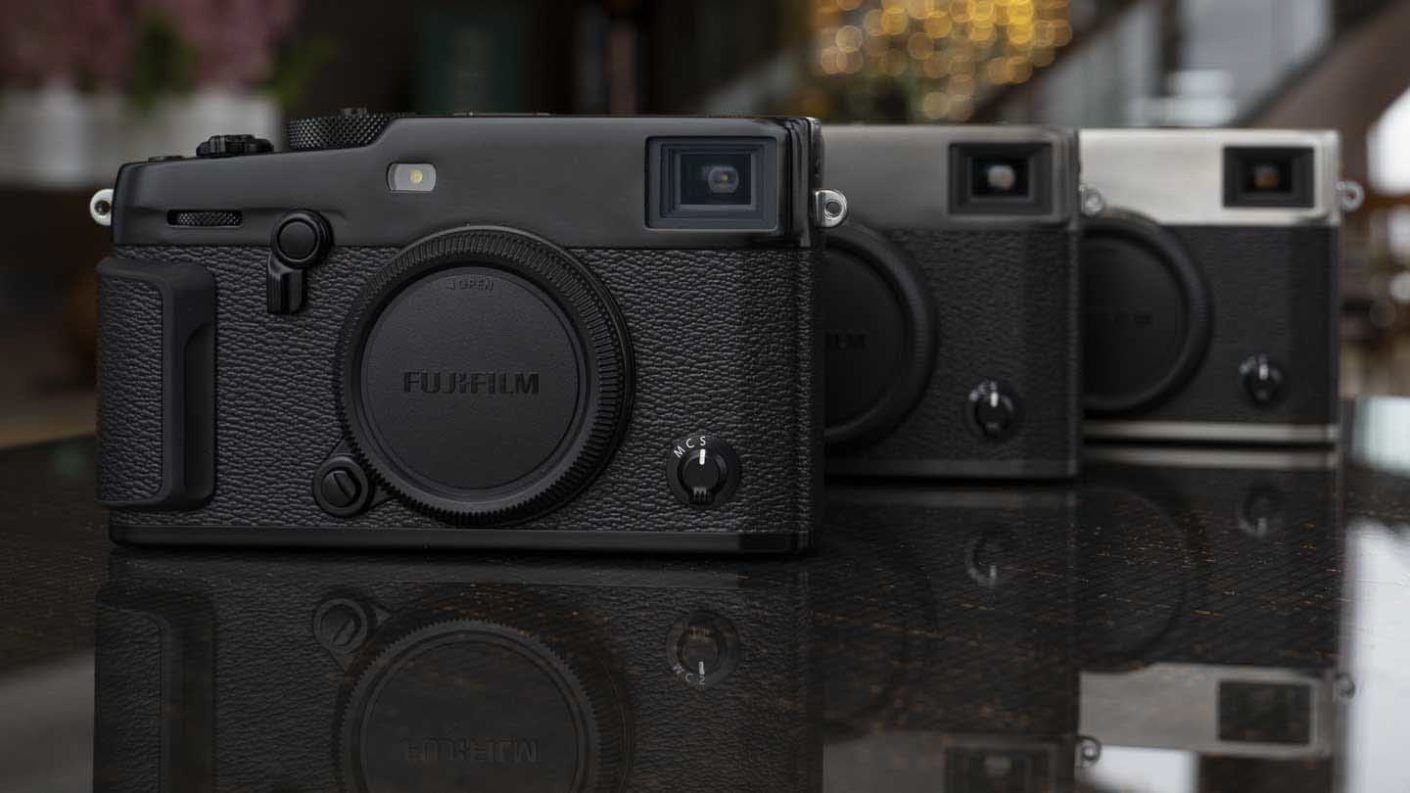
Specification
- Camera type: Mirrorless
- Sensor: 26.1Mp APS-C format (23.5 x 15.6mm) X-Trans CMOS 4
- Lens Mount: Fujifilm X
- Processing Engine: X Processor 4
- Autofocus system: Intelligent Hybrid AF Single point AF: 13×9 / 25×17 AF points Zone AF: 3×3 / 5×5 / 7×7 from 91 areas on 13×9 grid Wide/Tracking AF: (up to 18 area) AF-S: Wide / AF-C: Tracking All
- Viewfinder: Hybrid, Optical: Reverse Galilean viewfinder with electronic bright frame, 95% coverage, x0.52 magnification, Electronic: 0.5-inch 3.69 million-dot OLED, 100% coverage, 0.66x magnification
- Screen: 1.28-inch, 1:1 LCD and 3.0-inch, 3:2, tilting 1.62 million dot touchscreen that tilts through 180-degrees
- Sensitivity range: ISO 160-12,800 (expansions settings of ISO 80/100/125/25600/51200)
- Continuous Shooting: 20fps using the electronic shutter for 79 Jpegs or 36 Lossless compression raw files, or 34 uncompressed raw files 11fps using the mechanical shutter for 145 Jpegs or 42 Lossless compression raw files, or 36 uncompressed raw files 30fps using the electronic shutter and with a 1.25 crop for 60 Jpegs or 35 Lossless compression raw files or 33 uncompressed raw files
- Storage: 2x SD/SDHC/SDXC UHS-II
- Video: DCI 4K(4096×2160) at 29.97p/25p/24p/23.98p and 200Mbps/100Mbps for up to 15min
- Dimensions (WxHxD): 140.5 × 82.8mm 46.1mm / 5.5in × 3.3in × 1.8-inches
- Weight: 497g / 17.5oz including battery and SD card, 447g / 15.8oz body only
I was lucky enough to go to the beautiful city of Florence with this camera. However, travelling in November meant that the weather wasn’t quite what you visualise when you think of Italy. Part-way through a photo walk, it began to rain. Not just a little light rain, it pelted it down.
Thankfully, I had a decent waterproof coat on, so I was OK. But the camera got a good soaking. However, it didn’t miss a beat and I was able to carry on shooting.
Read our Fujifilm X-Pro3 Review: Updated with Full-Resolution Images
£1668
$1799.95For
- Superb build quality
- Hybrid viewfinder combines optical and electronic units
- Great new Classic Neg Film Simulation mode and excellent image quality
Against
- The main screen is hidden from view
- Shape not suited to use with long lenses
- Awkward ISO dial
GoPro Hero9 Black

Specification
- Camera type : Action Camera
- Announced: 16th September 2020
- Max video resolution and frame rate: 5k 30p, 4K 60p, 2.7K 120p, 1440 120p, 1080 240p
- Video file formats: MP4 (H.264/AVC), MP4 (H.265/HEVC)
- Max photo resolution: 20mp
- Max bit rates: 100Mbps (2.7K, 4K, 5K)
- Screen: Rear: 2.27-inch touchscreen, Front: 1.4-inch colour screen
- Livestreaming: 1080p
- Voice control: 4 commands in 11 languages + 6 accents
- Battery: Removable, rechargeable 1720mAh lithium-ion
- Storage: MicroSD USH-I
- Connectivity: Wi-Fi, Bluetooth
- Stabilisation: Hypersmooth 3.0
- Waterproof: To 10m / 33 feet
- Dimensions (WxHxD): 71 x 55 x 33.6mm
- Weight: 124g
The GoPro Hero5 Black was the first of GoPro’s Hero range of action cameras to not require a waterproof housing to survive being taken underwater.
We’ve given every GoPro we’ve had some through testing and they’ve come out as if nothing has happened.
A couple of years ago, Jeff took a Hero5 Black white water tubing in Scotland. He had it mounted on a head strap for a POV (point of view) video of him jumping off a cliff into a pool. The camera came off and it took him a good five minutes to find it, but it was fine.
Similarly, I’ve surfed with the Hero6 Black and it’s been thrashed about in waves for a couple of hours or so, submerged a lot and rolled in sand, but it’s fine.
Ali is on a mission to collect as much mud as possible on a GoPro Hero9 Black, and when he gets home it has a thorough rinse in freshwater.
He’s also taken it kayaking and given it a good dunking, but it lives on and is asking for more. Meanwhile, I’ve chucked mine about on a beach, rinsed it in the sea and filmed below the surface.
Basically, the GoPro Hero9 Black is waterproof and weatherproof and is built to take some abuse.
£330
$349.98For
- No need for waterproof housing
- Dual Screen
- 8X Slow-motion
Against
- Mods are expensive
- Not great in low light
Nikon Z50
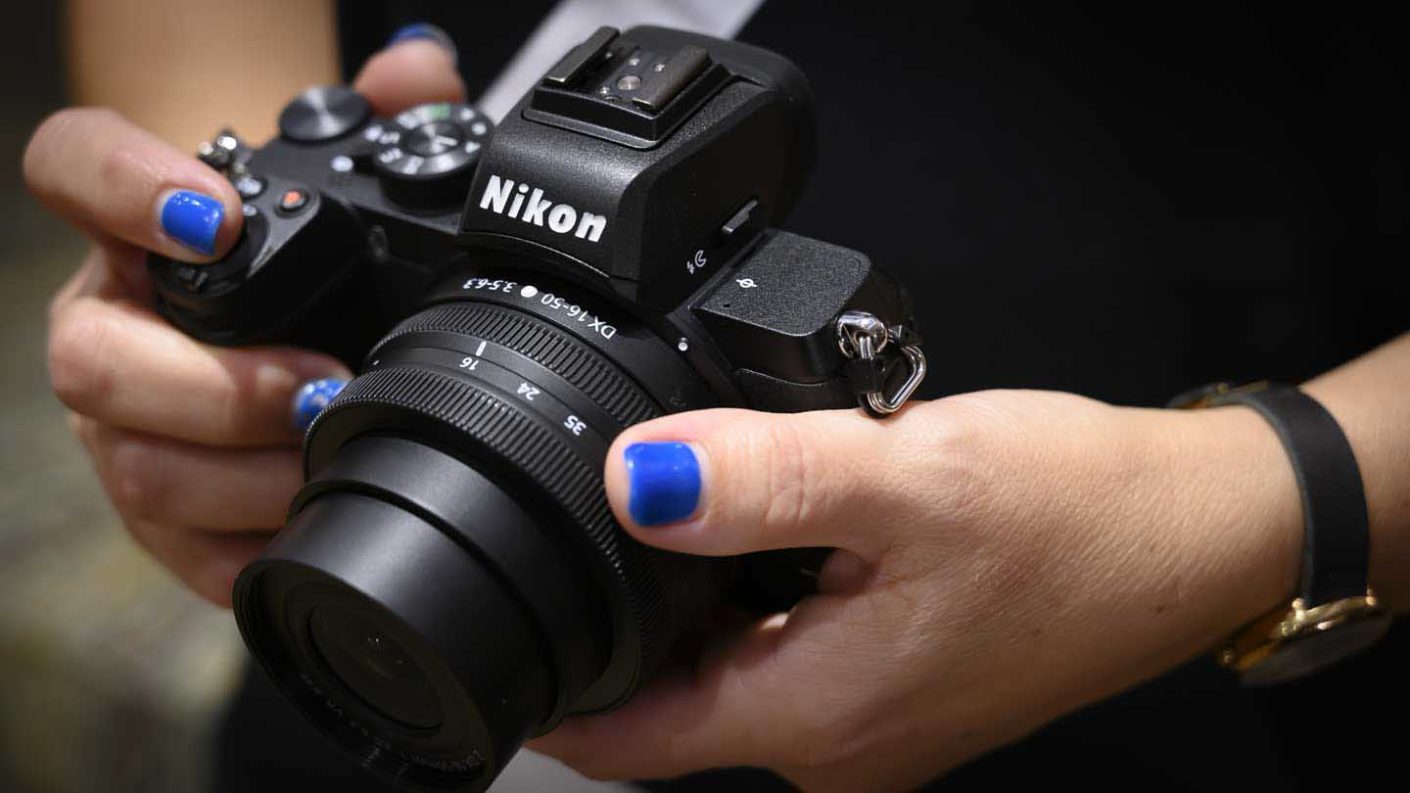
Specification
- Camera type: Mirrorless
- Sensor: 20.88Mp APS-C / DX (23.5x15.7mm) CMOS
- Processing engine: Expeed 6
- Lens mount: Nikon Z mount
- Sensitivity range: ISO 100-51,200; expands to 204,800
- Viewfinder: 0.39-inch 2,360,000-dot OLED electronic viewfinder
- Screen: Tilting 3.2–inch 1,040,000-dot touchscreen
- Autofocus: Hybrid (phase and contrast detection) AF with 209 AF points, Eye AF and Subject Tracking. Firmware V.20 adds Eye-detection AF for Animals as well as humans
- Continuous Shooting: 11fps with continuous AF and exposure metering
- Video: 4K at 30fps and Full-HD at 120fps
- Storage: SD/SDHC/SDXC UHS-I
- Connectivity: Snapbridge 2.6; Wi-Fi, Bluetooth
- Dimensions (W x H x D): 126.5 x 93.5 x 60 mm / 5 x 3.7 x 2.4-inches
- Weight: 450g / 15.9oz with battery and memory card but without body cap, 395g /14oz body only
According to Nikon, the Z50 is weatherproof to the same standard as the Nikon D7500. I had the opportunity to find out what that means when I tested the Z50 for our review and I took it to a local rugby match.
When I arrived the sun was out, but the clouds soon rolled in and by half time it was chucking it down. From then until the end of the match it was either yakking it down or drizzling. The camera was wet for the whole time.
Thankfully, the Z50 and the Nikkon Z DX 50-250mm f/4.5-6.3 VR I was using with it carried on regardless.
What especially impressed me, however, was the way the autofocus system performed.
Once the clouds rolled, in the light it got very gloomy but when the rain started it the light became very poor and the contrast plummeted. However, the Z50 carried on regardless.
That’s particularly noteworthy because I was shooting at the long end of the Z DX 50-250mm f/4.5-6.3 VR, which means the maximum aperture was just f/6.3. That’s hardly the sports pro’s choice!
£849
$989For
- Superb build and handling
- AF fast and accurate in low light
- Weatherproof
Against
- No joystick
- Can't use the screen to set the AF point while you look in the viewfinder
Nikon Z7
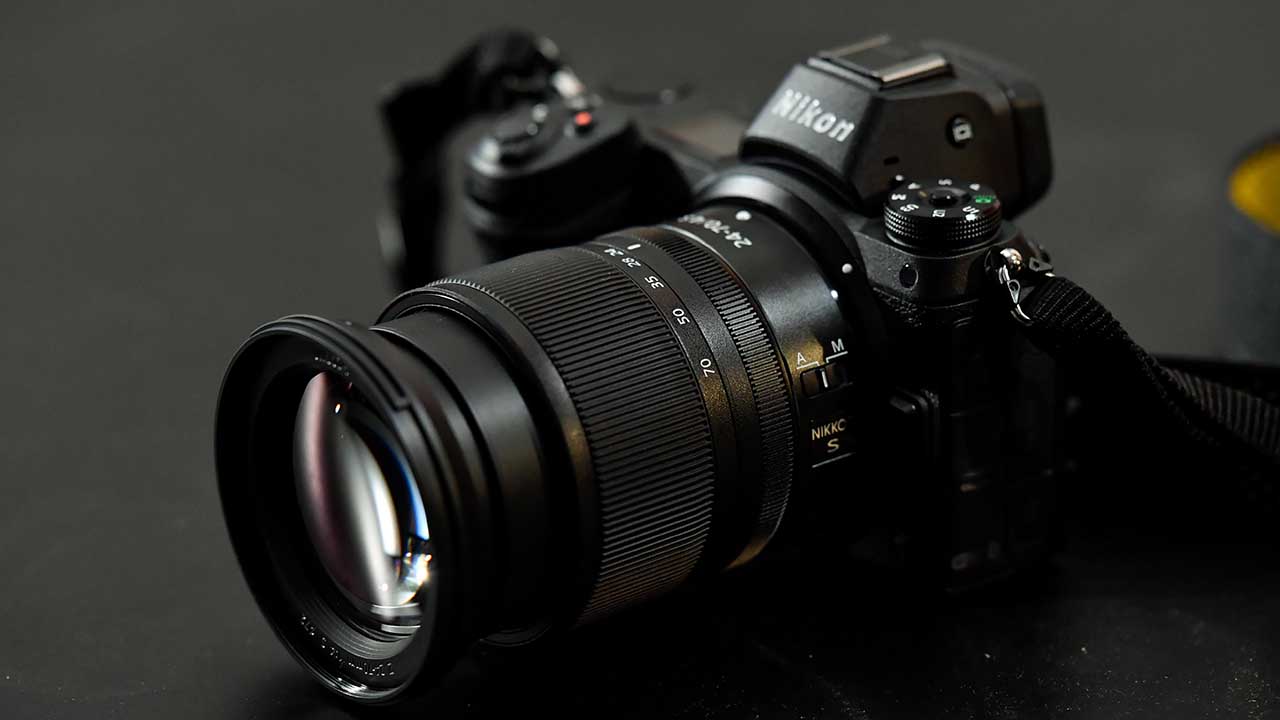
Specification
- Camera type: Full-frame mirrorless camera
- Sensor: Full-frame (FX) 45.7MP backside illuminated (BSI) sensor
- Lens mount: Nikon Z
- Autofocus system: Hybrid with phase and contrast detection
- Phase detection points: 493
- Storage: XQD/CFexpress
- Viewfinder: 0.5-inch 3.69-million-dot electronic viewfinder
- Screen: 3.2-inch 2,100,000-dot tilting touch-screen
- Dimensions (W x H x D): 134 x 100.5 x 67.5mm / 5.3 x 4 x 2.7-inches
- Weight: 675 g / 1 lb. 7.9 oz with battery and memory card but without body cap, 585g/1 lb. 4.7 oz. body only
When it introduced the Z7, Nikon claimed that it’s waterproof to the same standard as the D850. That’s handy because, during our testing, I used it to photograph a football match in the pouring rain. It didn’t just rain for a bit during the match. It was raining before I arrived and it chucked it down for the full 90 minutes – and all through half-time.
The camera was exposed to a thorough drenching and it continued to work throughout, and after.
Further good news here is that the Nikon Z6 has the same level of weatherproofing as the Z7. I haven’t tried to drown the Z6 yet, but I’m confident it would survive if I did.
£2299
$3399.00For
- High-quality sensor
- Excellent user interface and control layout
- Weatherproof build
Against
- Single XQD card port
- Images slow to appear after shooting
- Battery life could be better
Nikon Z7 II
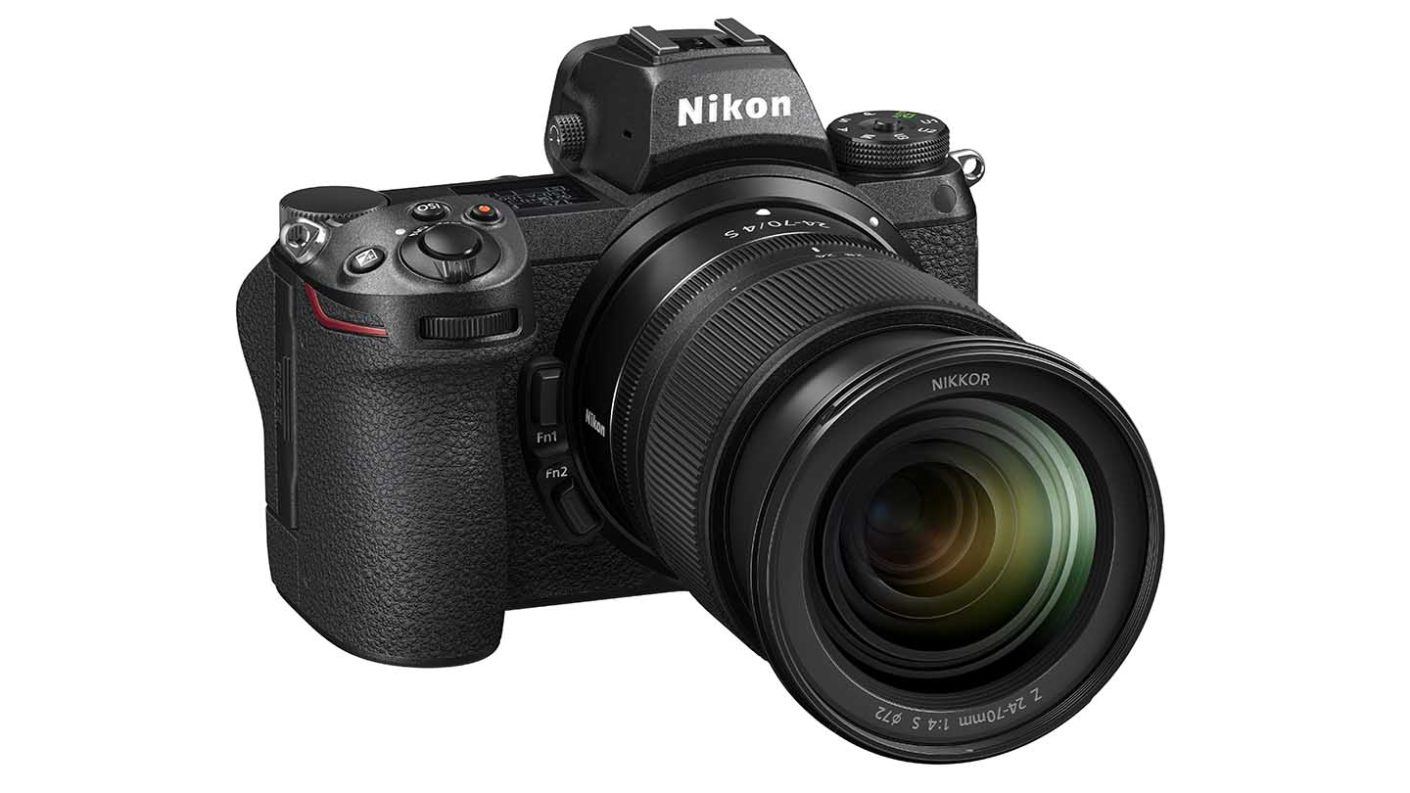
Specification
- Camera type: Full-frame mirrorless camera
- Announced: 14th October 2020
- Lens mount: Nikon Z
- Sensor: Full-frame (FX 35.9 x 23.9mm) 45.7MP backside illuminated (BSI) sensor
- Processing engine: Dual Expeed 6
- Stabilisation: 5-axis in-body VR
- Sensitivity: ISO 64-25,600, expandable to ISO 32-102,400
- Maximum continuous shooting rate: 10fps for up to 200Jpegs or 77 12-bit uncompressed raw files, 9fps with 14-bit raw files
- Autofocus system: Hybrid with phase and contrast detection
- Phase detection points: 493
- Video resolution: 4K (3840 x 2160) 60/50/30/25/24p, Full-HD (1920 x 1080) 120/100/60/50/30/25/24p, Slow-motion mode 1920 x 1080 30p x4/25p x4/24p
- Viewfinder: 0.5-inch 3.69-million-dot electronic viewfinder
- Screen: 3.2-inch 2,100,000-dot tilting touch-screen
- Storage: Dual slot 1 XQD/CFexpress and 1 SD/SDHC/SDXC
- Dimensions (W x H x D): 134 x 100.5 x 69.5mm / 5.3 x 4 x 2.8-inches
- Weight: 705g with battery and memory card but without body cap, 615g body only
Just like the Nikon Z7, the Z7 II has proved itself to be very weatherproof. Because of the pandemic, I haven’t been able to use it on a rain-lashed touchline, but it’s accompanied me on some very wet walks and come out of it looking a lot happier than me.
I’ve also shot with the Z7 II on a windy beach and not had to worry about what the sand might do. As the Nikon Z6 II is built with exactly the same weatherproofing, it would survive the same treatment.
£2999
€3442 / $2996.95For
- High-quality sensor
- Excellent user interface and control layout
- Weatherproof build
Against
- A vari-angle screen is of more use than a tilting screen for portrait orientation images
- The viewfinder resolution is no longer class-leading
- The Eye-detection AF isn't a match for Sony's or Canon's most recent systems
Olympus Tough TG-5
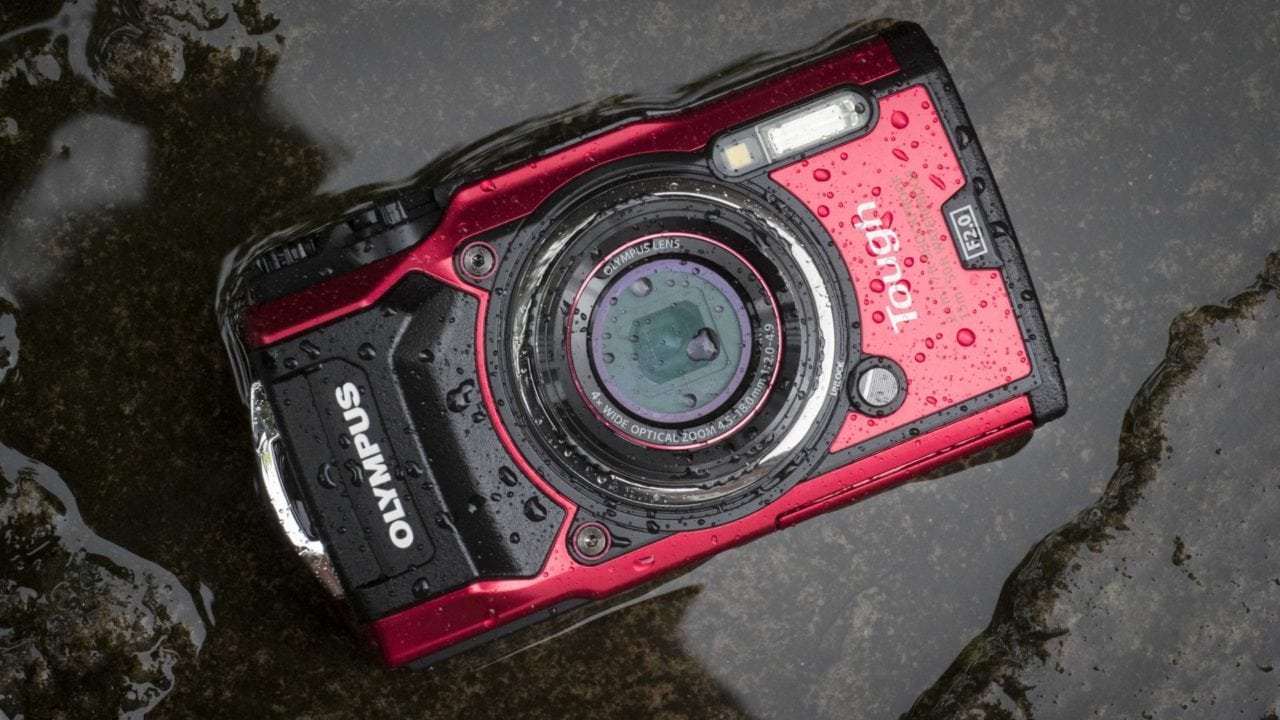
Specification
- Camera type: Compact
- Sensor: 12Mp 1/2.33-inch CMOS
- Lens focal length: 4.5-18mm (25-100mm 35mm equivalent)
- Viewfinder: N/A
- Screen: 3-inch 460,000-dot LCD
- Sensitivity range: ISO 100 ‑ 12800
- Storage: SD/SDHC/SDXC
As they are billed as waterproof cameras, when I tested the Olympus Tough TG-5 and TG-6 , I exposed them to plenty of water. But Jeff, or rather his boys, took testing the TG-5’s waterproofing to new limits.
The Tough TG-5 lives up to its name, so Jeff was happy to let his kids use it to satisfy their burgeoning interest in photography and video. But one day it went missing. It wasn’t found until a week later and it was lying at the bottom of a paddling pool.
Fearing the worst, Jeff fished the TG-5 out and wiped off the green slime to discover that it still worked. And months later, it’s still working! That’s impressive.
Read our Olympus Tough TG-5 review
Read our Olympus Tough TG-6 review
£355
$399.00For
- Waterproof to 15m without a housing and drop-proof from 2.1m
- Versatile focal length equivalent to 25-100mm
- Can shoot raw files
Against
- No viewfinder built-in
- No touchscreen (that would be a problem underwater)
Olympus OM-D E-M1 Mark II
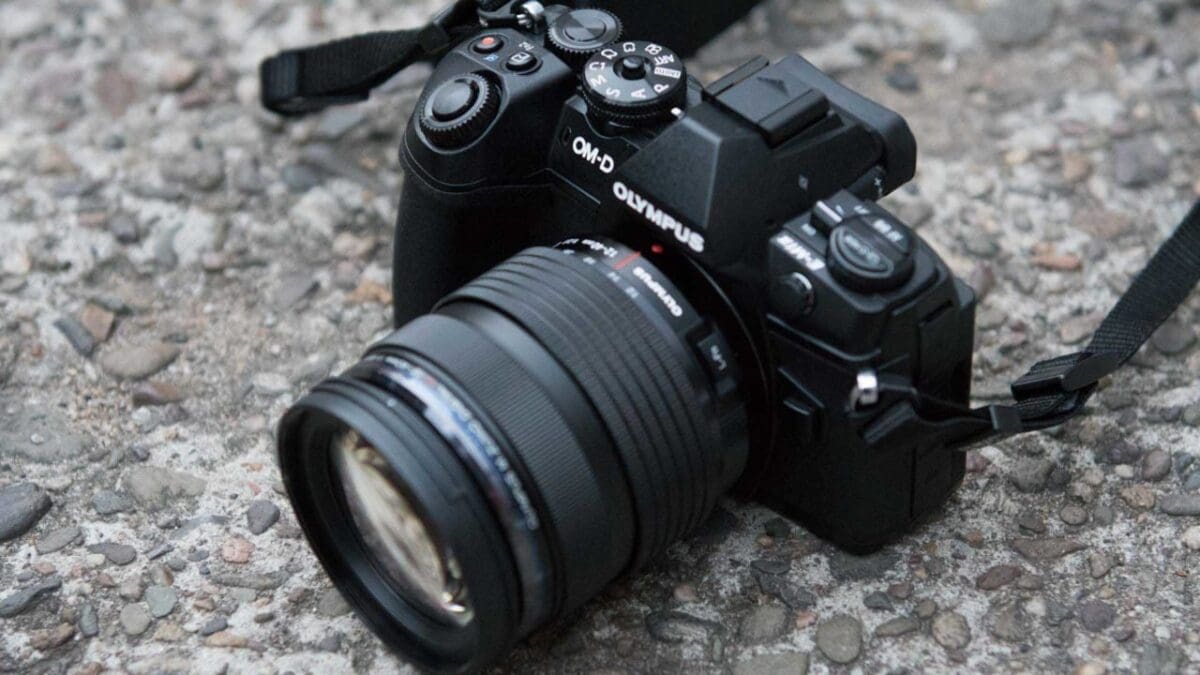
Specification
- Camera type: Mirrorless camera
- Sensor: Four Thirds-type 20.4Mp Live MOS
- Processing engine: TruePic VIII
- Lens mount: Micro Four Thirds
- Autofocus system: Hybrid with 121 all cross-type focusing points
- Max continuous shooting rate: 18fps with AF tracking, 60fps with AF locked on first frame with electronic shutter
- Max video resolution: 4K (4096 x 2160) at 24p
- Viewfinder: 2,360,000-dot electronic viewfinder
- Sensitivity range: ISO 64-25,600
- Screen: Vari‑angle 3-inch 1,037,000-dot touchscreen
- Storage: 2x SD/SDHC/SDXC (UHS-II)
- Dimensions (W x H x D): 134.1 x 90.9 x 68.9mm
- Weight: 498g (body only), 574g (including battery and memory card)
Olympus is rightly proud of the weatherproof credentials of cameras like the OM-D E-M1 Mark II, OM-D E-M1X and OM-D E-M5 Mark III.
These credentials came in handy when took the OM-D E-M1 Mark II on a photo walk one rain-sodden night in London. As I stood on Tower Bridge, bracing myself and my tripod against the wind, the camera continued to deliver the goods.
It was one of those nights when the wind seems to swirl about, so I was forever wiping the front element of the lens. I was freezing cold and soaking wet, but seeing the traffic trails building up on the screen on the back of the camera as I shot in Live Composite mode kept me rooted to the spot. It’s quite addictive, even in atrocious weather.
Read our Olympus OM-D E-M1 Mark II review
The Olympus OM-D E-M1 Mark III has the same level of weatherproofing as its predecessor, so there should be no concerns about using it in poor weather.
£1499
$1299For
- Fast and accurate focusing with moving subjects
- Superb stabilisation system
- Innovative features
Against
- High price
- Comparatively small sensor limits scope to restrict depth of field
- High Res Shot mode a tripod only mode
Panasonic Lumix G9

Specification
- Camera type: Micro Four Thirds mirrorless camera
- Sensor: 20.3 million Four Thirds type (17.3 x 13mm)
- Burst Mode: 20fps with AF-C, 60fps with AF-S
- Autofocus: 225-point Contrast detection
- Video: 4K (3840 x 2160) at 60p, 50p, 30p, 25p, 24p with no cropping
- Dimensions (W x H x D) : 136.9 x 97.3 x 91.6 mm / 5.39 x 3.83 x 3.61 inch (excluding protrusions)
- Weight: 658g / 1.45lb including 1 SD card x and battery, 586g / 1.30lb body only
The Panasonic Lumix G9 is another camera that’s been subjected to 90-minutes of appalling weather at my hands. Once again it was at a rugby match, but this time the rain was falling from the outset, all through the first half, half time and the second half. The whole damn match.
As I switched the end I was shooting from at half-time, both I and the camera were fully exposed to the worst that the wind and rain had to throw at us. The camera was drenched, I was drenched. But we both carried on shooting.
And yes, the camera was fine afterwards.
£1499
$1698 / €1729For
- Compact weather-sealed body
- Stabilisation system rated at 6.5EV
- High-quality EVF and screen
Against
- Sub-full-frame sensor
- Awkwardly positioned joystick controller
- 400-shot battery life in standard mode


